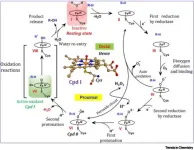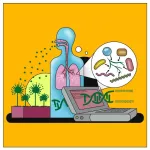(Press-News.org) A remarkable breakthrough, a collaborative team of researchers, led by Professor Yaakov Nahmias from The Hebrew University of Jerusalem, Technion-Israel Institute of Technology, and Tissue Dynamics Ltd., has unveiled a miniature human heart model that could potentially transform drug testing and cardiovascular research. This study, published in Nature Biomedical Engineering, introduces a self-paced multi-chambered human heart model, no larger than a grain of rice, which promises to revolutionize the way we study the heart and its functions.
Cardiovascular diseases remain the leading cause of global mortality, underscoring the critical importance of this pioneering work. Professor Nahmias and his team embarked on an intricate endeavor to create an accurate replica of the human heart using human induced pluripotent stem cells (hiPSCs). The resulting model comprises multiple chambers, pacemaker clusters, epicardial membrane and endocardial lining, all meticulously designed to mimic the structure and functions of the human heart.
One of the most significant features of this heart model is its ability to provide real-time measurements of essential parameters such as oxygen consumption, extracellular field potential, and cardiac contraction. This capability enabled the scientists to gain unprecedented insights into heart function and diseases, making it a game-changer in the field of cardiovascular research.
The heart model, approximately the size of half a grain of rice, represents a remarkable feat in cardiac research and holds immense potential for precision drug testing. Already, the research team has made groundbreaking discoveries that were previously unattainable using conventional methods. Notably, the heart model unveiled a new form of cardiac arrhythmia, distinct from those observed in traditional animal models, thereby offering new avenues for studying human physiology.
The implications of this discovery extend to the pharmaceutical industry, as it allows researchers to gain invaluable insights into the precise effects of pharmaceutical compounds on the human heart. The heart model's response to the chemotherapeutic drug mitoxantrone, commonly used to treat leukemia and multiple sclerosis, was carefully tested. Through these experiments, the researchers pinpointed how mitoxantrone induces arrhythmia by disrupting the heart's electro-mitochondrial coupling. Encouragingly, the team also discovered a potential solution by administering metformin, which showed promise in mitigating the drug's adverse effects.
Professor Nahmias, Director of the Grass Center for Bioengineering at The Hebrew University of Jerusalem and a fellow of the Royal Society of Medicine and AIMBE, emphasized the significance of their work. “The integration of our complex human heart model with sensors, allowed us to monitor critical physiological parameters in real-time, revealing intricate mitochondrial dynamics driving cardiac rhythms. It is a new chapter in human physiology”, said Nahmias. Partnering with Tissue Dynamics, the scientists developed a robotic system that can screen 20,000 tiny human hearts in parallel for drug discovery applications. The potential applications of this micro-physiological system are vast, promising to enhance our understanding of heart physiology and accelerate the discovery of safer and more effective pharmaceutical interventions, leading to a healthier future for all.
By offering unparalleled accuracy and insights into cardiovascular diseases, this advanced human heart model has the potential to revolutionize drug testing methodologies. With this tiny heart model, researchers are poised to make significant strides in developing safer and more effective medications for patients worldwide, potentially saving lives and improving patient outcomes.
Moreover, the miniature heart model also presents an ethical advantage, as it offers a viable alternative to animal testing. This breakthrough discovery could mark a turning point in the pharmaceutical industry, reducing reliance on animal models and minimizing potential harm to animals in the pursuit of medical advancements.
In conclusion, the tiny heart model developed by Professor Nahmias and his team represents a monumental achievement with far-reaching implications for medical research. This miniature yet sophisticated human heart model has the potential to reshape drug testing practices, advance our understanding of cardiovascular diseases, and ultimately contribute to a healthier and more sustainable future.
Link to pictures and video: https://drive.google.com/drive/folders/1x4myGjpPyTr1vXyLhLms1WoGPQv7XQIZ?usp=sharing
Credit for pictures and video: Tissue Dynamics
Credit for picture of Yaakov Nahmias – Hebrew University
Research Team: Mohammad Ghosheh-1,2; Avner Ehrlich-1,2,3, Konstantinos Ioannidis-1,2,3, Muneef Ayyash1,2, Idit Goldfracht-4, Merav Cohen-1,2,5, Amit Fischer-6, Yoav Mintz-7,8, Lior Gepstein-4,9 & Yaakov Nahmias-1,2,3,5
1-Alexander Grass Center for Bioengineering, The Hebrew University of Jerusalem; 2-The Rachel and Selim Benin School of Computer Science and Engineering, The Hebrew University of Jerusalem; 3-Tissue Dynamics, LTD, Jerusalem; 4-Sohnis Research Laboratory for Cardiac Electrophysiology and Regenerative Medicine, the Rappaport Faculty of Medicine and Research Institute, Technion- Israel Institute of Technology; 5-Department of Cell and Developmental Biology, The Hebrew University of Jerusalem; 6-Department of Biological Chemistry, Institute of Chemistry, The Hebrew University of Jerusalem; 7-Department of General Surgery, Hadassah Hebrew University Medical Center; 8-Faculty of Medicine, Hebrew University of Jerusalem; 9-Cardiology Department, Rambam Health Care Campus
Acknowledgements: Funding was provided by the European Research Council Consolidator Grant OCLD (project no. 681870) and generous gifts from the Nikoh Foundation and the Sam and Rina Frankel Foundation. M.G. was supported by a Neubauer Foundation Graduate Fellowship.
The Hebrew University of Jerusalem is Israel's premier academic and research institution. With over 25,000 students from 90 countries, it is a hub for advancing scientific knowledge and holds a significant role in Israel's civilian scientific research output, accounting for nearly 40% of it and has received over 11,000 patents. The university's faculty and alumni have earned eight Nobel Prizes and a Fields Medal, underscoring their contributions to ground-breaking discoveries. In the global arena, the Hebrew University ranks 77th according to the Shanghai Ranking, making it the top-ranked Israeli institution. To learn more about the university's academic programs, research initiatives, and achievements, visit the official website at http://new.huji.ac.il/en
END
As Canadian wildfire smoke continues to impact large swaths of the United States, resulting in poor air quality and negative health outcomes for millions of Americans, more people than ever are feeling the effects of longer fire seasons and a changing climate. Now, researchers at Washington University in St. Louis have discovered that wildfires may have even bigger climate impacts than previously thought.
In a new study published Aug. 7 in Nature Geoscience, researchers led by Rajan Chakrabarty, the Harold D. Jolley Career Development Associate Professor in the ...
Most individuals diagnosed with opioid use disorder are not on recommended medications and even fewer remain in care, according to a research letter published today in JAMA Internal Medicine by lead author Ashley Leech, PhD, assistant professor in the Department of Health Policy at Vanderbilt University Medical Center (VUMC).
In 2021, there were more than 100,000 overdose deaths in the United States, with the highest rates among those ages 25-54.
Just 22% of the 40,000 individuals with opioid use disorder studied by VUMC researchers continuously used ...
[Jerusalem, Israel] Study reveals an important discovery in the realm of nanomachines within living systems. Prof. Sason Shaik from the Hebrew University of Jerusalem and Dr. Kshatresh Dutta Dubey from Shiv Nadar University, conducted molecular-dynamics simulations of Cytochromes P450 (CYP450s) enzymes, revealing that these enzymes exhibit unique soft-robotic properties.
Cytochromes P450 (CYP450s) are enzymes found in living organisms and play a crucial role in various biological processes, particularly in the metabolism of drugs and xenobiotics. The researchers' simulations demonstrated that CYP450s possess a fourth dimension - the ability to sense and respond to ...
An international team of scientists led by the University of Southampton has discovered that the breakup of tectonic plates is the main driving force behind the generation and eruption of diamond-rich magmas from deep inside the Earth.
Their findings could shape the future of the diamond exploration industry, informing where diamonds are most likely to be found.
Diamonds, which form under great pressures at depth, are hundreds of millions, or even billions, of years old. They are typically found in a type of volcanic rock known as kimberlite. Kimberlites are found in the oldest, thickest, ...
Aspergillus fumigatus strains that infect humans have a significantly altered metabolism compared to other strains in the environment. At the same time, infection with the fungus leads to an apparent change in the human lung microbiome. Researchers at the Leibniz Institute for Natural Product Research and Infection Biology (Leibniz-HKI) in Jena, Germany, came to this conclusion after using machine learning models to analyze genome data from about 250 fungal strains and lung microbiome data from 40 patients.
The fungus Aspergillus fumigatus is widely distributed in the environment, where it performs important ecological functions. ...
Nancy Holincheck, Assistant Professor, Advanced Studies in Teaching and Learning, School of Education; Jessica Rosenberg, Associate Professor, Physics and Astronomy; Stephanie Dodman, Associate Professor, School of Education; and Benjamin Dreyfus, Associate Professor, Physics and Astronomy, received funding from the National Science Foundation for the project: "EAGER: Quantum is Elementary: Quantum Teaching & Learning in Elementary Classrooms."
The researchers will study learning associated with elementary teachers' engagement in professional learning and elementary students' learning related to quantum science, quantum thinking, and careers. The ...
Although the collapse of hives of European honey bees (Apis mellifera) has gained worldwide attention in recent years, there are massive gaps in knowledge of other bee species, particularly in the Asian region, which contains over half the world’s human population and where food security (in which bees play a key role) remains a major challenge.
According to a recent global analysis, only 1% of the global public data on bee distribution comes from Asia, even though 15% of the world’s bee species are thought to live there.
In a new paper, “Opportunities and challenges in Asian bee research and conservation”, published in the journal ...
INDIANAPOLIS – Chronic pain is often accompanied by depression and anxiety. In an invited commentary published in JAMA Network Open, Kurt Kroenke, M.D., of Regenstrief Institute and Indiana University School of Medicine, discusses the relationship between pain, the most common symptom for which individuals visit a physician, and depression and anxiety, the two most prevalent mental health conditions worldwide. He highlights the importance of not neglecting psychological symptoms in patients experiencing pain.
“One of the reasons for the bi-directional linkage between pain and depression, as well as anxiety, is the existence of a feedback ...
The T. Boone Pickens Foundation, established by the late, Texan innovative energy leader and philanthropist, is donating $20 million to the Wilmer Eye Institute, Johns Hopkins Medicine. The gift, announced in 2013, is one of the largest research donations in Wilmer’s history. It will fund vision-saving research and a professorship.
Pickens’ interest in the treatment and research of eye conditions developed in the 1980s after his father’s diagnosis of macular degeneration, a progressive condition that disrupts the central field of vision and causes ...
SAN ANTONIO — August 7, 2023 —Southwest Research Institute is helping the freight rail industry assess potential pathways to decarbonization with a new open-source modeling and simulation software known as ALTRIOS. ALTRIOS, the Advanced Locomotive Technology and Rail Infrastructure Optimization System, can simulate the real-world impacts and expenses related to adopting alternative energy locomotive technologies and expanding associated infrastructure.
Now publicly available for download, ALTRIOS supports several simulation modes to provide rail industry stakeholders with optimal strategies for implementing ...










